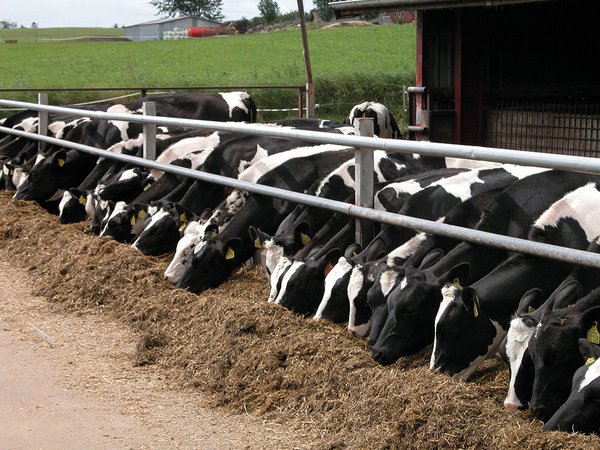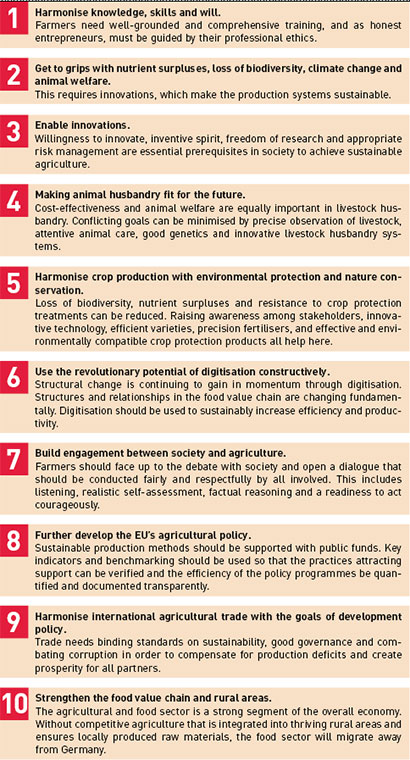 Download this article in magazine layout
Download this article in magazine layout
- Share this article
- Subscribe to our newsletter
A self-correction force: The 10 Theses of the German Agricultural Society
Every ten years, in the framework of a convention, the German Agricultural Society develops a future scenario for German and European agriculture for the next 20 years. In addition to the forecast market developments, the cornerstones of the conference in autumn 2016 above all concerned the sustainability of agricultural systems.
With a sustainability assessment of the individual farm and a survey of the sector in the context of a sustainability report for German agriculture (2014 and 2016), the DLG has already been pursuing an approach for ten years in which sustainability is not appraised qualitatively but quantitatively, on the basis of indicators. For example, the organisation has already been pointing out for several years that the task ahead is not only that of mastering the challenge of a growing demand for agricultural products, which is also a significant challenge that the European agricultural sector faces, but that we have to be self-critical in addressing the issue of whether the current agricultural production systems really meet the demands of sustainability.
The global scenario regarding Agenda 2030
In brief, we were able to establish the following in our analysis in the context of the convention:
In 2030, global agriculture will be facing the challenge of providing food for 8.5 billion people. According to calculations performed by the United Nations Food and Agriculture Organization (FAO), by 2030, global demand for grain will have risen by around 8 per cent, for pork by 19 per cent, for poultry meat by 17 per cent, and for milk and dairy products by 10 per cent compared to 2015 figures. Over the same period, global available farmland per capita will have declined from around 2,200 square metres in 2015 to roughly 2,000 square metres in 2030. The reasons for these developments are population growth, urbanisation, desertification and salinisation.
By 2030, the Sustainable Development Goals (SDGs) of the United Nations are to be achieved as well. A catalogue with 17 goals for sustainable development forms the core of this Agenda 2030. All 17 goals are of equal importance in this set, and they are closely linked to one another. For example, productivity and the conservation of important environmental goods such as climate, water and species diversity form a unit together with the other goals. Goal 2, “End hunger, achieve food security and improved nutrition and promote sustainable agriculture”, describes a topic that is of outstanding importance to agriculture.
Further gains in productivity, attained in a sustainable manner in the sense of the Brundtland Report “Our Common Future”, assume a key role. The DLG Position Paper “Landwirtschaft 2030” (agriculture in 2030) takes a determinedly critical look at agricultural systems in fields and stables. Neither the aspects of nutrient surpluses, species decline and climate change nor animal welfare point to systems that are sustainable in every respect.
Challenges facing the achievement of sustainable agriculture by 2030
Restricted crop rotation, increasing resistance regarding chemical pesticides or diseases among animals kept in stables resulting from how they are looked after cannot be explained solely by referring to cost management aimed at more competitiveness. Rather, they challenge the creativeness of farmers regarding production technology and, in particular, their innovativeness. There are many options to simultaneously enhance productivity and sustainability, ranging from intelligently bred plant varieties or animal races through agricultural and animal housing engineering to the new opportunities that digitalisation offers.
This also requires a social environment that is open to such innovations. We have to garner understanding in society for our licence to operate. We have powerful arguments, both professional and emotional (“What is fascinating about agriculture”), and as farmers, we have a duty to deliver in terms of communication. This applies in particular, but not only, to developed, industrial societies.
Forward-looking agricultural policy also has to take up the challenge of sustainability and productivity. Here, modern processes are just as important as indicator-based measuring of sustainability. It can serve as a measure in a transparent analysis of the status quo, in measuring the success of political programmes and also for the benefits offered by innovations.
International agricultural trade provides the opportunity to balance local or temporary supply deficits among agricultural products. Especially given unevenly distributed availability of resources, natural precipitation, temperatures and soil quality, this has a considerable impact on productivity and sustainability. However, international agricultural trade ought to be in accord with development co-operation goals.
Farmers only rarely provide regional, national and, in particular international markets with primary products. Rather, the latter are further processed in an increasingly complex manner and are sold as quality products by food retailers virtually throughout the world. This is why integration in efficient quality chains that internally optimise processes and are able to organise cross-regional distribution is indispensable. In the long run, value chains can only be as strong as their individual segments. This would argue in favour of a fair distribution of value chain shares within the chain, which unfortunately is not always the case.
Today, one year after the DLG presented its ten theses on agriculture in 2030 (see Box), one can observe a discussion process covering agriculture as a whole and focusing on a very concrete, more sustainable development of the branch in the future. That a branch should have the strength to engage in self-criticism and self-correction is increasingly proving to be a sign of strength and optimism about the future.
Carl-Albrecht Bartmer is Chairman of the German Agricultural Society’s Supervisory Board and is himself a farmer.
Contact: HGF@dlg.org






Add a comment
Be the First to Comment